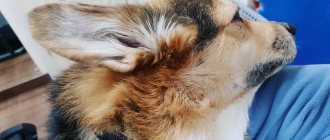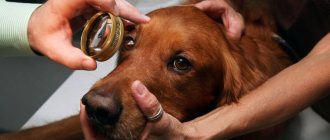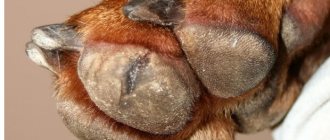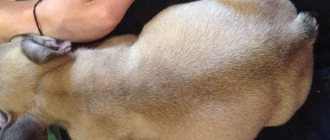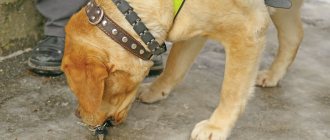Description and breed standard
Male height at withers: 58-71 cm
Height of the bitch at the withers: proportionally less
Weight: 15.8-32 kg
Color: any colors and combinations are allowed, however, brindle color is extremely undesirable and points will be reduced for it at shows.
additional characteristics
The length of the body from the shoulders to the base of the tail should be approximately equal to the height at the withers, otherwise the dog will appear disproportionate.
The standard specifically states that the appearance of the animal must be noble . It is also specifically stated that movements should be swift, but graceful, and it should not be noticeable that the dog is making an effort.
The Saluki's coat There are long-haired and short-haired Salukis; the former have a kind of “fluff” of wool on their legs and head (and sometimes on their chest). They also have fluffy ears.
The nose is black or liver brown, the eyes are very dark to hazelnut colored, large and oval.
Description
The Saluki has a graceful and sophisticated appearance, and in many ways resembles a Greyhound with a thick coat. They have been purebred for thousands of years and their entire appearance speaks volumes about it. They are tall, but they are thin.
At the withers they reach 58–71 cm, females are slightly smaller. Their weight is 18–27 kg. They are so thin that the ribs are visible under the skin. Often people think that a dog is suffering from malnutrition, when this is its normal appearance.
This build allows the Saluki to be fast, since extra pounds significantly affect their speed; they can run at a speed of almost 70 km/h.
The breed has an expressive muzzle, very long and narrow. The eyes are large, oval, dark brown or hazel in color. The expression of the muzzle is touching and affectionate, intelligence shines in the eyes. The ears are significantly longer than those of other greyhounds and hang down.
They are smooth-haired and “feathered”. The second type is much more common than smooth-haired ones; in photographs from the show they can only be seen. Both varieties have long hair on the ears, but the long-haired variety has longer hair, plus it has feathering on the tail and back of the legs.
They can be any color except brindle and albino. The most common are: white, gray, fawn, red, black and tan, piebald.
History of the Saluki
Most dog experts agree that this is the very first domestic dog breed . Most likely, the breed originated in the territory that ran from Ancient Egypt along the Mediterranean coast and ended in Mesopotamia on the shores of the Persian Gulf. These were the most fertile lands in the region.
The most capable dogs were bred. Since the poor worked in the fields and pastures to feed their masters, those who could afford to go hunting were engaged in divorce. At first they hunted for food, but then it became elite entertainment, which immediately raised the price of the dog.
"Wedding at Cana", 1562-1563, artist Paolo Veronese. The Saluki can be seen in the center of the canvas.
It is known for certain that in 329 BC. Alexander the Great himself kept Salukis and even took his pets on his campaign to conquer India. The Arabs used the breed to herd the gazelle, the fastest of all antelopes.
Presumably this particular breed was depicted on the inner walls of Egyptian pyramids dating back to 2000 BC. e.
Recently, researchers announced that mummified dogs found in the pyramids are also the ancestors of the breed. But the burials date back to the 6th millennium BC. e.!
In the Middle Ages and the Renaissance, European monarchs became interested in the breed. For example, the Duke of Saxony Henry IV (1473-1541) is depicted in one of the frescoes with his pet.
Henry IV of Saxony, artist Lucas Cranach
“Praise of the Magi”, 1573, artist Paolo Veronese. Saluki in the lower right corner.
In the 1840s, the breed came to England, which then set the tone in cynology. The British developed an interest in the Middle Eastern breed, which coincided with the discovery of Tutankhamun's , where drawings of these dogs were also found. To the credit of the British, they respected the characteristics of the Saluki and bred them in accordance with the rules adopted in Arab countries.
In the 20th century, all federations gradually recognized the Saluki as a separate breed; now single-breed exhibitions are held on all continents except Antarctica.
Salukis are classified as greyhound dogs . The latest version of the standard was adopted in 2000.
History of the breed
The Saluki is considered the oldest breed, perhaps one of the first. Little is known about its appearance, since it happened thousands of years ago. The first dogs were domesticated somewhere in the Middle East and India.
They differed little from their relatives - wolves, except that they were more friendly towards humans.
They accompanied hunter-gatherer tribes for hundreds of years. As the tribes migrated, living conditions also changed.
Domesticated dogs became more and more different from wolves. Those dogs were similar to modern dingoes, the New Guinea Singing Dog and the mongrels of the Middle East.
This can be seen in the images that the peoples of Ancient Egypt and Mesopotamia left us.
As villages grew into cities, a ruling class began to emerge. This class could already afford entertainment, one of which was hunting.
Most of Egypt is open space: deserts and steppes, where gazelles, small antelopes, rabbits and birds graze.
The hunting dogs of this region had to have the speed to catch up to prey and good eyesight to see it from a distance. And these dogs were valued by the Egyptians, many were found mummified, they were supposed to be companions in the afterlife.
The images of the dogs of the ancient Egyptians remind us of modern pharaoh dogs and Ibicenco podencos, then they were called “tesem”. But, over time, images of ribbons begin to supplant images of a dog, which is different in appearance.
On them you can see dogs very reminiscent of modern Salukis, with which they hunt in a similar way. The first images of these dogs are found between the 6th and 7th centuries BC.
The same images can be found in Sumerian sources of that time. Experts argue where the Salukis came from - from Egypt or Mesopotamia, but the answer to this question will never be found.
These regions trade extensively with other countries and influence them significantly. No matter where it comes from, Salukis are quickly spreading to other countries in the region.
It is impossible to say where they came from, but the fact that they were the ancestors of modern dogs is a fact. Recent genetic studies have identified 14 breeds whose genomes differ minimally from wolves. And Saluki is one of them.
It is believed that the Saluki descended from the Tesem, but this is nothing more than an assumption based on the similarity of the breeds. If her ancestors were other dogs, then there is no evidence left of their appearance. This is probably the oldest breed that has come down to us almost unchanged.
The lands of the Fertile Crescent carried on brisk trade throughout the Middle East and Salukis found their way to Greece and China and became popular on the Arabian Peninsula. The Salukis were apparently very important in the ancient world, and some biblical scholars believe they may be mentioned in the Bible.
For a long time it was believed that it was they who gave rise to all breeds of greyhounds, from the Greyhound to the Russian Borzoi. But genetic studies have shown that they are not related and each breed developed separately. And their external similarity is only the result of similarity in application.
However, the Saluki definitely played a role in the appearance of the Afghan hound.
Among all the invaders of Egypt, none brought as many cultural and religious changes as the Arabs and Islam. In Islam, a dog is considered an unclean animal; they cannot live in a house, and the meat of animals caught by a dog cannot be eaten.
In fact, many people refuse to even touch the dog. However, an exception is made for the Saluki. She is not considered a dog at all. Called El Hor in Arabic, it is considered a gift from Allah and is not subject to prohibition.
The first Salukis came to Europe with the Crusaders. They captured the dogs in the Holy Land and brought them home as trophies. In 1514, a dog similar to a Saluki is depicted in a painting by Lucas Cranach the Elder.
Medieval artists painted it in paintings depicting the birth of Christ. However, in Europe at that moment it was not widespread, probably due to the fact that forests predominated there. Around the same time, it finds its way into China, as it can clearly be seen in a 1427 painting of the emperor.
In the 18th century, the British Empire conquered Egypt and most of the Arabian Peninsula. Officers, administration and their families arrive in the region.
They start keeping Salukis as hunting dogs and adopt them when they return home. Salukis and Slughis were originally called 'Slughis' in English, although they were rarely crossed with each other.
However, before 1895 they were still unpopular. That year, Florence Amherst saw these dogs for the first time while on a Nile cruise and decided to get a pair.
She brought them from Egypt to England and created a nursery. Over the next ten years, she works hard to popularize the breed and its development.
She is not only the first breeder, but also the creator of the first breed standard, published in 1907. She took as a basis the standard of other breeds already recognized by the English Kennel Club: Irish Wolfhound, Whippet and Scottish Deerhound. For a long time she had only seen one type of Saluki, so the standard was written for that.
The first popularity of the breed came in 1920. English troops are sent to Egypt to suppress the uprising and again take dogs with them. One of these people was Major General Frederick Lance.
He and his wife Gladys were avid hunters and returned from the Middle East with two Salukis from Syria, which they use for hunting.
These dogs were of northern strains that lived in the colder, mountainous climates of Iraq, Iran and Syria. Accordingly, they differed in appearance, they were stocky, with longer hair.
Lance and Amhers apply to the Kennel Club for breed recognition. And it was recognized in 1922, when the tomb of Tutankhamun was found and everything Egyptian became wildly popular. In 1923, the Saluki or Gazelle Hound Club was founded and dogs began to be imported from their homeland.
By the mid-1930s, the fashion for Egyptian was fading and along with it interest in Saluki. The Second World War practically destroys it; only a few dogs remain in England. After the war, the population was restored using these dogs and importing them from the East. However, she is not under threat, as she is very popular in her homeland.
In most Islamic countries, the Saluki is the most numerous breed of dog, but in the West and in Russia it is much more rare.
Character and temperament
This breed definitely has its own opinion, although its entire life is devoted to its owner . Moreover, they become attached to one person in the family. Yes, the Saluki will be friendly to everyone, and will even obey, but you should not be mistaken about it: it will immediately choose the one who will become its true owner, and will be completely devoted only to him.
They are very tactful ; they will even accompany their beloved owner like a shadow, but will not persistently seek his attention through active actions.
It is very important for this breed that its owner is the leader of the entire “pack”, then it will feel comfortable and confident. A Saluki will not show aggression towards people if it is not threatened.
They do not really like games that other dogs enjoy; for example, if they bring a thrown ball to their owner, it will be on command and without any pleasure.
Salukis do not like to be bored or stay at home alone for a long time. If this pet gets bored, it can have disastrous consequences for the home.
Character
An independent breed whose character is often called cat-like. They love their owners, but if you want a dog that is incredibly affectionate, then it is better to choose a beagle or spaniel. Saluki loves one person and is attached only to him.
They are suspicious of strangers and dogs that have not been socialized often become nervous around them. However, they are not aggressive and are definitely not suitable for the role of watchdog.
They are tolerant of children as long as they do not harass or hurt them, but they are not particularly loving. Most Salukis do not like games at all, except maybe skeet.
They are extremely sensitive to touch, but some often react with fear. They don’t like noise and screams; if you have constant scandals in your family, it will be hard for them.
Salukis have hunted in packs for thousands of years and can tolerate the presence of other dogs, rarely showing aggression. Dominance is also unknown to them, although they are not pack dogs and do not suffer from the absence of other dogs.
This is a hunter a little more than completely. The Saluki will chase almost any animal smaller than itself, and sometimes larger. There are few breeds whose hunting instinct was also strong.
You should not keep them together with small animals, although training can reduce the instinct, but not defeat it.
If she sees a squirrel, she will rush after it at full speed. And he can catch up with almost any animal, attack it and kill it.
They can be trained to be around cats, but you need to start as early as possible. But you need to remember that if a Saluki carries a domestic cat, then this rule does not apply to the neighbor’s.
They are difficult to train, freedom-loving and stubborn. They don’t like being told what to do; they are guided by their own desires. They need to be trained only through affection and treats, never using force or shouting.
Training a Saluki will take more time than training other breeds and they are not suitable for obedience.
Due to the tendency to chase animals and selective hearing of commands, it is necessary to let them off leash only in areas without blades. Even the most trained Salukis sometimes prefer to chase prey, ignoring commands.
At the same time, they are faster than the fastest person on the planet and it will not be possible to catch up with them. If they live in the yard, then the fence should be high, as they jump well.
At home they are calm and relaxed, preferring to sleep on the sofa rather than on the rug. But outside the home, they need activity and freedom, so that they have the opportunity to run around and let off steam. A daily walk is required.
They bark occasionally, but are generally quite quiet. However, any dog barks out of melancholy or boredom, it’s just that Salukis are less susceptible to them. They can be picky eaters and owners have to resort to tricks to satisfy the dog.
Dog and man
This is not to say that the Saluki is suitable for keeping in an apartment. Like any hunting breed, it needs to realize its irrepressible energy. The best place to live would be a house with a fenced yard . The fence must be high.
Since the popularity of hunting, especially in European countries, has fallen, the Saluki is gradually transforming into a companion dog without losing its excellent physical shape. She has attracted many people with her devotion and will be able to become a family dog. At the same time, you must always remember that she will adore only one person , and just treat the rest well.
By the way, when choosing this breed, you should carefully evaluate your willingness to spend her entire life with her: the Saluki will not be able to accept a new owner , she will remember the first owner, and this will affect her behavior and mood.
With children, this dog will be careful and restrained, but will not allow any pinching or kicking in its direction. Rest assured, she will respond, not necessarily with a bite. She may growl and bark loudly, although the possibility of biting cannot be completely ruled out. Therefore, this breed is recommended for those whose children have already grown to a more or less conscious age.
The Saluki is not very suitable for older people, as it requires a lot of physical activity and a firm hand when training. However, if you are full of life, then this pet will only add color to it.
Salukis are favorable towards representatives of their breed and can accept another dog. There were cases when these pets got along with cats, but in this case the cats were the first pet in the family.
Important: do not risk having any small pets after this swift beauty has appeared in your home. Its hunting instinct cannot be suppressed by any training. That's why cats, rabbits, ferrets, guinea pigs and chinchillas are taboo!
Historical reference
The breed is very ancient, because it is not known exactly where and when it appeared. The homeland of the Saluki is the Middle East. There is a legend that the breed received its name from the city of Saluk in the south of the Arabian Peninsula.
Drawings from Ancient Egypt depicted dogs similar to Salukis with which the pharaohs hunted game back in the 7th century BC.
Alexander the Great's love for the Saluki dog breed is well known.
The Persian hound occupies a special place in Arab traditions; nomadic peoples considered dogs not purebred, and this breed was revered and allowed to enter the home.
The Saluki and the horse are the Arab's most precious possessions; The Saluki is capable of developing enormous speed, keeping up with the light-footed Arabian stallion.
Saluki (Persian greyhound)
Each tribe had hunting dogs suitable for a particular area, so there are characteristic types of Persian greyhound, formed by climatic conditions and terrain features. In the ancient world, the breed could not be bought or sold, but was given as a gift as a form of homage.
The Arabs valued them as Arabian horses; they were even taken to the hunting ground on horseback next to their owner.
Further references to the Persian hound can be found on the territory of the Arabian Peninsula, China, Greece and Europe. In the 17th century, Britain conquered Egypt and in 1840 the Saluki appeared in England , where in 1895 Florence Amherst began breeding it. In 1907 she created the first standard for the breed, and in 1923 the breed was officially recognized.
The Persian Greyhound has been valued at all times for its working qualities and aristocratic appearance. The breed evolved from a hunting dog to a family pet, but retained its historical roots, maintaining speed, flexibility, endurance and hunting instinct.
Maintenance and care
Salukis should only be walked on a leash . Even the strictest upbringing will not stop her if she sees an animal that she regards as prey. At the same time, she does not notice anything, not even speeding cars. If you let her go into the yard of your house, then check if there are any loopholes, otherwise, if she sees a squirrel or cat, the Saluki will chase it.
This breed needs a long walk and, preferably, free range. She will keep herself in shape.
Saluki owners are often asked the question: “Do you even feed your dog?” . Don't pay any attention to him. Yes, the Saluki will have visible ribs . This breed eats and drinks little, moreover, they are picky eaters and will not eat everything that is given to them. Arabian breeders, who are recognized as the most experienced, provide Salukis with natural food. Their menu includes:
- Veal and lamb;
- Chicken and turkey;
- Fish;
- Solid vegetables: carrots, beets, celery, cabbage stalks, pumpkin;
- Unsweetened fruits: apples, pears (citrus fruits should not be given);
- Sometimes dairy products: natural yoghurts and cottage cheese;
- Boiled eggs 2-3 times a week;
- In addition, breeders from Arab countries believe that this breed does not need grains .
It is better to feed your dog in small portions: Salukis have a high metabolic rate. You can always choose dry food, but then it is better to choose expensive varieties and the type of food that is suitable for active animals.
The Saluki is a clean dog and has virtually no odor. She avoids puddles and dirt in every possible way during walks; she needs to be washed if she gets dirty. Brush your Saluki once a week to remove loose hair and distribute skin oils. Periodically you will have to trim your nails and keep your ears clean. Your dog needs to brush its teeth twice a week.
This breed does not tolerate cold weather , so for winter walks you need to buy warm overalls. The owners of these dogs recommend insulating her sleeping place : life there should be cozy and warm, regardless of the time of year.
Training and baiting
It is typical for Salukis to test their owner's strength before submitting. This is a very proud breed, and it will only obey its leader. Therefore, when she resists, you must be persistent, but not cruel. Saluki often plays a game of “who will out-stubborn whom.” Once she understands that you are a leader, there will be no problems with obedience.
However, no one can suppress her instincts and forbid her to run after the “prey”.
start socializing your dog immediately after the second vaccination and subsequent quarantine. Over the course of a month, try to show her to as many people as possible. Let her smell new smells and see unfamiliar places.
Saluki does not require baiting when hunting antelope, hares, foxes and other animals - natural instinct will work. This breed needs training if you suddenly decide to hunt a wolf with it, this is explained by the too close genetic connection between wolves and greyhounds.
This baiting begins at one year of age . The wolf is taken to a field and released there. The hunter must bring an experienced huntress to accompany the young greyhound. When she chases a predator, the inexperienced dog will begin to copy the behavior of her friend.
If the Saluki, during 2-3 training sessions with an experienced hunter, cannot show healthy anger towards the wolf and capture it correctly, then the dog is not suitable for such a hunt.
Features of the breed and character of the Saluki
The biggest feature of the breed can be considered its age. These dogs were presented to each other as gifts by noble Elamites, and this was in 3500 BC. This fact is confirmed in Elamite ceramics, Egyptian paintings, and Babylonian sculpture.
In the Bedouin tribes roaming the desert, this animal was considered in ancient times and is now considered a gift from heaven or a gift from Allah to people. This dog is still prohibited from being sold in some places; it can only be given as a gift as a sign of respect for the person.
It was as a gift from one of the Middle Eastern rulers that the Salukis ended up in China during the Tang Dynasty, that is, around 650 AD. In the same way, these dogs ended up on the territory of modern Turkmenistan and Kazakhstan.
In absolutely any photo of Saluki dogs, their refined gracefulness is visible, but their agility and speed are not visible - the animals easily overtake horses. When hunting, the Saluki overtakes the prey and holds it until the hunter arrives.
In European countries, these amazing dogs found themselves in the Middle Ages, and immediately became the heroes of tapestries and paintings, mainly aristocratic family portraits.
Many artists who painted “to order” noted that Salukis pose much more patiently than their owners. Modern breed standards were approved in 1963 in Britain, and in 1966 they were approved by the International Canine Federation.
As for character, this animal is very silent, Salukis practically do not bark, if the dog gives a voice, it means that something completely exceptional has happened. These dogs are extremely proud, have a sense of dignity and cannot stand familiarity and rudeness.
They are quite affectionate with children, but they will never become nannies or playmates, preferring to watch from a little distance. But they will also not allow the child to leave the playground or for a stranger to approach him. The qualities of the Saluki as a guard dog are quite controversial. However, this breed has all the data to become a sensitive watchman.
Health and life expectancy
On average, a dog lives from 12 to 14 years , it is not susceptible to genetic diseases, but there are several typical diseases:
- Sensitivity to anesthesia. The Saluki requires less anesthesia than other dogs of the same weight due to its small body fat.
- Cardiomyopathy. Indicates changes in the heart muscle.
- Hypothyroidism. Low levels of thyroid hormones, which leads to infertility, obesity, and mental retardation.
At the same time, the owners say that the dog is very healthy and strong, and diseases rarely bother them. The American Canine Association says the disease affects no more than 5% of dogs.
Puppy characteristics
When planning to purchase a Saluki puppy, you need to find a breeder with a good reputation. You should not make a purchase without first getting to know the puppies and evaluating the proposed options based on the photos.
A healthy and purebred Persian greyhound puppy should be playful, moderately well-fed and very active. While the dog is not yet grown, there may be areas of long hair on its shoulders and back. Greyhound puppies grow quite quickly, but at heart they remain spoiled and mischievous children until they are 2 years old.
Similar articles
Breed photo
A selection of photos of noble Salukis.
Interesting facts: Greyhounds, including Salukis, are recognized by Muslims. Other dogs are considered unclean animals.

